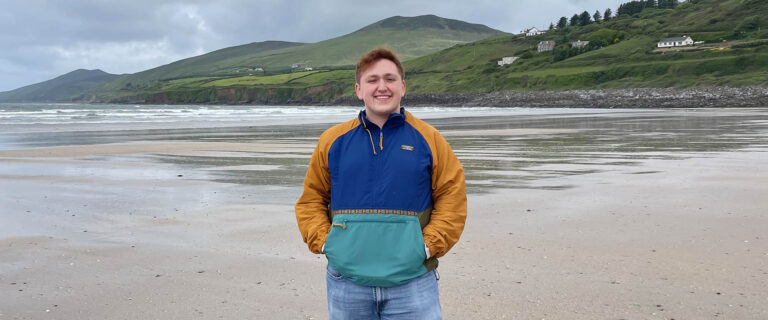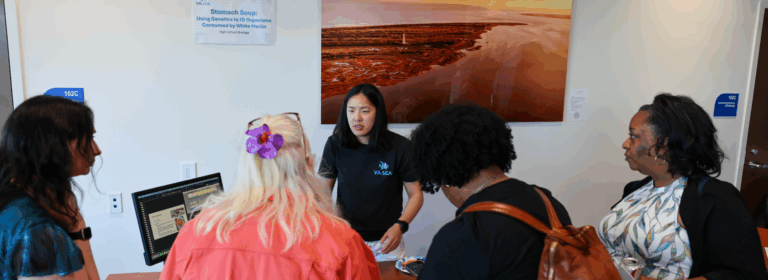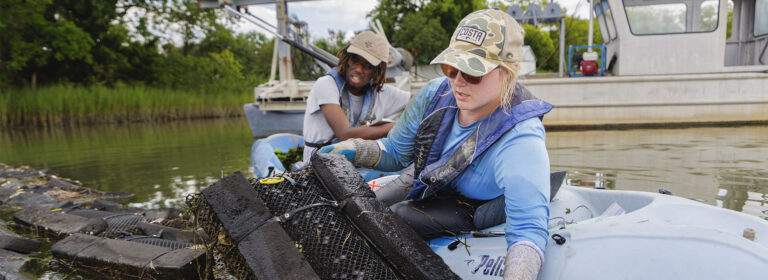Secretary of Natural and Historic Resources and Chief Resilience Officer Ann Jennings speaks to invited guests gathered for the release of the Virginia Coastal Resilience Master Plan held at the Old Point National Bank Building in downtown Hampton on Tuesday, Dec. 7, 2021.
Sea Grant fellows assist with first Virginia Coastal Resilience Master Plan
Virginia’s first Coastal Resilience Master Plan was released Tuesday by the Governor’s office. The plan includes maps for storm surge and tidal flooding up to the year 2080, and how critical infrastructure will be affected by that flood hazard — information that wasn’t consistently available across Virginia’s coastal zone until now. The plan also includes project priorities, compiles projects already underway, and offers funding sources available for future projects.
Compiling the information to make this possible took multiple years, but the process was launched in November 2018 when Governor Ralph Northam signed an executive order to increase Virginia’s resilience to storms and sea level rise. As Northam appointed Rear Admiral (Retired) Ann Phillips as Special Assistant to the Governor for Coastal Adaptation and Protection to spearhead the plan’s formation, some of the future Virginia Sea Grant fellows like Ben Nettleton who would help create this plan were already in the room.
“I remember thinking, ‘That’s a big order, to get this done in this administration,’ and wondering how they’re going to get that done,” Nettleton said. “Little did I know that I would be part of making it possible.”
But before Phillips could identify any larger priorities, she first created a list of projects and programs already underway within government agencies. To help with this effort, Sasha Brauer from William & Mary Law School and Lesley Morton from The George Washington University, did background research as part-time assistants.
Lesley Morton
Sasha Brauer
Ben Nettleton
Morton focused on resilience-themed programs at state agencies like the Virginia Department of Transportation, focused on infrastructure resilience. Brauer helped research existing funding sources. Ultimately, the final plan included funding resources.
Throughout Virginia, many coastal cities and counties have started projects already to boost local resilience, from zoning to erosion control. But completing an inventory of statewide coastal resilience — and organizing regional needs and priorities — was a tall task.
In the summer of 2019, Phillips was aided by two full-time VASG Coastal Adaptation and Protection Fellows Anna-Beth Lawler and Shurui Zhang, as well as a yearlong fellow, Ben Nettleton. The team assisted Phillips with data collection, documentation, meeting preparation, and research at the early stages of drafting the master plan.
The Virginia Sea Grant fellows worked alongside a Virginia Management Fellow and a Department of Conservation and Recreation fellow to look at resilience plans from other states and met with regional planning district commissions in Virginia.
“We were data mining and trying to think how we would describe hazards, or how we would describe various types of infrastructure activities, natural and nature-based features, hardscape, gray infrastructure, hybrid infrastructure,” Phillips said.
Phillips also listened to local communities share their experiences with coastal flooding through public outreach meetings.
Shurui Zhang
Anna-Beth Lawler
Lydia Bienlien
The next updates to the master plan, anticipated by 2024, will likely include other important hazards like riverine flooding and flooding from rain.
Ultimately, the first step toward a comprehensive master plan was a master planning framework — a shorter document that identified what’s at stake in coastal Virginia, and the goals and objectives for the full master plan, like showing the impacts of nuisance flooding. The document also included maps Zhang created to visualize flood risks.
“We can see what houses may be submerged, but then how many more extensive areas are going to be flooded at high tides and experience these nuisance flooding events?” Nettleton said. “We worked with researchers and actually produced a brand-new model for the Commonwealth that shows nuisance flooding, and areas of land impacted.”
Then, a technical advisory committee for the master plan ensured that the information from state agencies, coastal planning districts, regional commissions, academic researchers, and others to ensure all the relevant information was incorporated into the final master plan. As the subcommittees met, Phillips directed them to resources already created by the fellows earlier in the planning process.
“When the subcommittees were going through the same things, I could say, ‘Wait, we already did that. Let me show you what we did.’ And I could send them something they could use,” Phillips said.
Phillips also listened to local communities share their experiences with coastal flooding through public outreach meetings, which Zhang helped organize in the fall of 2020 before additional staff from the Department of Conservation and Recreation joined the master plan effort.
The next updates to the master plan, anticipated by 2024, will likely include other important hazards like riverine flooding and flooding from rain. Future plans could also improve the inventory of resilience projects or updates to available funding sources. In the coming year, VASG Coastal Adaptation and Protection Fellow Lydia Bienlien will assist with additional outreach for the master plan.
“Without bright and creative and inventive young minds, we would not be as far as we are,” Phillips said.
Takeaways:
- Virginia’s first Coastal Resilience Master Plan was released Tuesday by the Governor’s office.
- From the plan’s inception in Nov. 2018 to now, six Virginia Sea Grant fellows have assisted with the plan’s formation.
- The fellows researched existing programs and projects, met with regional planning district commissions to assemble information, helped draft documents, checked citations, created graphics, and assisted with public outreach for the plan.
Photos by Aileen Devlin | Virginia Sea Grant
Story by Madeleine Jepsen | Virginia Sea Grant
Published December 10, 2021.
“Without bright and creative and inventive young minds, we would not be as far as we are,” Phillips said.





